The Best Leg Exercises For All Fitness Levels
The best leg exercises to add to your regime, from beginner lower-body moves for home, to the gym machines which develop strength and build muscle
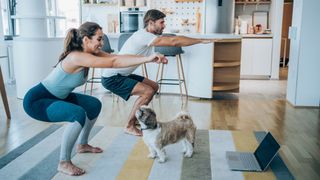
It’s always tempting to skip leg day, mostly because no-one enjoys the DOMS that tends to follow a hard set of leg exercises. No weight-training plan is complete, however, without at least one leg-focused workout a week.
This doesn’t need to involve shifting barbells loaded with heavy weights. You can work your legs out effectively at home with no equipment or just a set of dumbbells.
We’ve picked our favourite beginner leg exercises to do at home and at the gym below, and we also have a section on the best leg exercises to do with dumbbells. Some of the moves have been picked out by Andy Page, strength and conditioning coach at the new Pure Sports Medicine Chancery Lane clinic, and we’ve supplemented those with our own favourites.
Andy Page is a strength and conditioning coach and clinical manager at Pure Sports Medicine’s Chancery Lane clinic in London. He has a master’s in sports and exercise nutrition to go along with his degree in sports and exercise science, both from Loughborough University, and spent five years working as a strength and conditioning coach at Leicester City FC before joining Pure Sports Medicine.
Beginner Leg Exercises To Do At Home
Squat
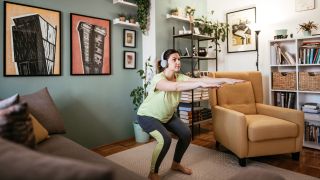
The quintessential leg exercise, and one with endless variations, but it’s best to start with the unweighted or “air” squat. From standing, engage your core muscles, bend your knees and push your hips back to lower until your thighs are at least parallel to the floor. Push through your heels to come back up.
Lunge
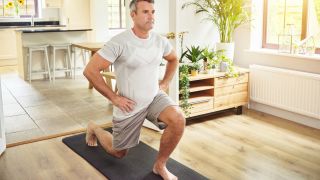
From standing, take a big step forwards on one leg and lower until both knees are bent at a 90° angle – don’t let your back knee touch the floor. Push back through your front heel to standing. Keep your core engaged and torso upright throughout the exercise.
Glute bridge

“The glutes are often overlooked but they’re a key muscle group,” says Page. “Strong glutes will make everything from running and squatting easier, as well as helping to keep you injury-free. One of the most common causes of lower-back pain is poor glute activity.
“The bridge is a great way to work on your glutes. Lying on your back with knees bent and feet flat on the floor, squeeze your glutes and push your heels into the floor to lift your hips into a bridge. You should finish with your hips straight and abdominals tight.”
Get the Coach Newsletter
Sign up for workout ideas, training advice, reviews of the latest gear and more.
Calf raise
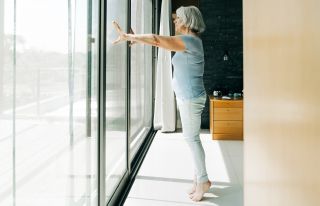
This simple leg exercise is just about the best way to work on your calves, which are not the easiest muscles in the body to target. If you’re a keen runner or sportsperson then calf raises are an absolute must, whether you do them in the gym or while waiting for the kettle to boil.
While standing, push down through the balls of your feet and raise your heel so you are up on your toes, then lower again. You can also do calf raises with your toes on the edge of a step which allows for a greater range of movement at the bottom of the move, or add weight to increase the challenge.
Bent-knee calf raise
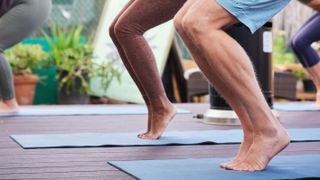
The classic calf raise focuses on the gastrocnemius muscle – the larger calf muscle – while the bent-knee variation of the move works the soleus, which is smaller but no less important. When adding the exercise to your routine it’s worth doing an equal mix of normal and bent-knee raises, and it’s easy to switch between them during a set – simply bend your knees slightly.
Wall sit
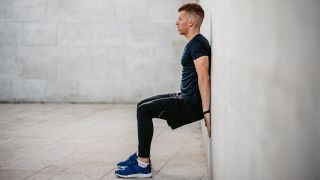
A nice easy leg exercise, this. Find a wall and sit back against it so your thighs are parallel to the ground and your knees are bent at 90°. Wait, did we say easy? We meant horribly hard, because after the first 15 seconds or so holding this position becomes absolute murder on your thighs. It’s worth it, though, because you’ll build serious strength in your quads. If you’re a runner you’ll be pleased to learn the move can help prevent the all-too-common injury known as runner’s knee.
Dumbbell Leg Exercises
Goblet squat

“Any lower-body programme should be built on the ability to squat,” says Page, “and the goblet squat is the ideal way to perfect the movement before moving on to its more complex cousins.
“Hold a kettlebell or dumbbell close to your chest, push your hips back and squat down slowly until your thighs are parallel to the ground. From this position, drive up to standing, leading with your chest. Working in front of a mirror will help to keep your knees in line with your feet and torso upright.”
Dumbbell step-up
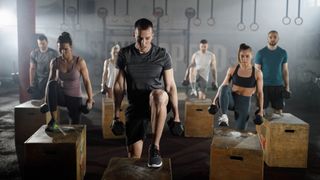
“The ability to lunge with good form has great carryover benefits to many other sporting movements as well as strengthening your hamstrings, quads, glutes and hips,” says Page. “With a dumbbell in each hand, lunge forwards and bend your front knee until your back knee is just above the ground, then drive back up. Bring the back leg through to initiate the next lunge and walk forwards to continue the movement. Focus on keeping your torso upright.”
Single-leg Romanian deadlift
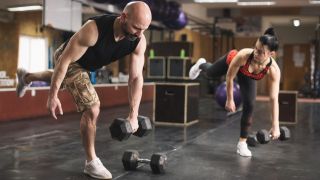
“This move incorporates balance, proprioception (your sense of where your body parts are positioned) and glute control as well as hamstring training,” says Page, “making it a great way to make the most of your training time.
“Holding a kettlebell or dumbbell in your left hand, lift your left leg straight behind you and lean forwards over your right leg by pushing your hips backwards, feeling the stretch down your right hamstring. Practise facing the mirror to keep your head up and your back straight, and make sure you are moving in straight lines and not rotating over your standing leg.”
Split squat

This compound exercise works the quads, hamstrings and glutes, and the single-leg focus makes it a great move for all athletes but runners in particular. From standing, take a big step forwards like you would with a lunge. Drop your back knee until it is almost touching the ground, then drive back up but stay in the split stance. Perform all your reps on one leg, then switch to the other.
Farmer’s walk
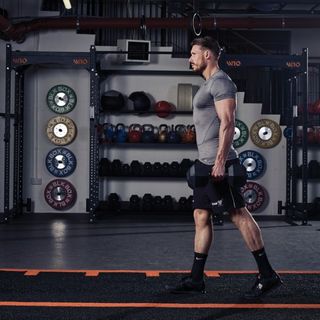
There’s a limit to the weight you can carry in this move, but that doesn’t mean your legs will have it easy – they’re going to spend more time under tension than in a typical sets and reps move. Walk holding heavy dumbbells or kettlebells by your sides with your core braced and chest up.
Gym Leg Exercises
Leg curl

The leg curl requires the use of a dedicated weights machine, so it’s one to do in the gym unless your house is unusually well kitted out with a multigym. The reason for doing leg curls is simple – it’s one of the most effective ways to strengthen your hamstrings. To do a seated leg curl (some gyms also have machines you lie on to perform the move), sit on and set up the machine so the padded lever sits just below your calves (also refer to the instructions on the specific machine you’re using). Raise your legs in front of you, then pull the lever back down using your legs.
Leg extension
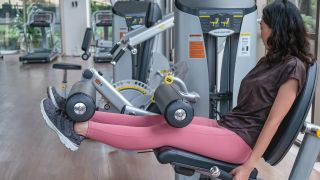
This weights machine exercise isolates your quads and is simple to perform, but it’s best done with light weights at first to avoid any risk of damaging your knees. Sit on the leg extension machine with your back straight against the backrest and adjust the pad so it sits on your shins just above the ankles. Hold the side bars and extend your legs out in front of you, making sure you’re powering the movement with your quads rather than kicking up with your feet.
Leg press
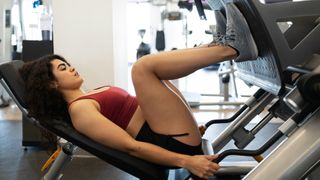
The leg press is another machine move, but unlike the leg extension and leg curl it doesn’t just focus on one muscle group: it works the quads, glutes and hamstrings in one fell swoop. Sit back on the machine with your feet on the plate shoulder-width apart. Release the handles so your legs take the weight, then lower your legs towards your chest slowly. Drive them back up, but don’t lock out your knees.
Hex bar deadlift
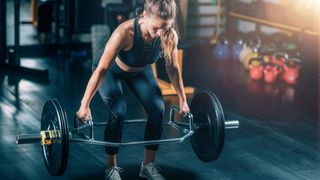
“Deadlifting is a great way to build strength in the posterior chain – your hamstrings, glutes and back – and lifting with the hex bar makes it far more accessible,” says Page.
“Standing inside the hex bar, hold both handles securely and lower your hips so they are as close to the height of your hands as possible. Slowly take the tension on the bar and then stand up, pushing through your glutes, to lift the bar. Keep your chest high with your head facing forward during the whole movement. When performed properly, the hex bar deadlift is a particularly good option for anyone with a sore back from years of orthodox deadlifting.”
Barbell back squat
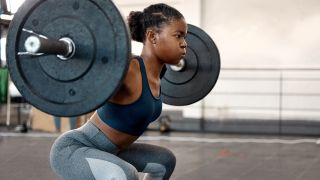
Once you’re comfortable with squatting without weights and dumbbell/kettlebell moves like the goblet squat, it’s time to step up to the barbell back squat. It’s a powerhouse of a move that delivers big benefits to your legs, but you need to do it right.
Unrack the bar and rest it on your rear shoulder muscles, standing with your feet about shoulder-width apart and your toes turned slightly outwards. Start the movement by sitting back as if aiming for a chair behind you, lowering until your thighs are at least parallel to the ground, then drive through your heels back to standing.
Sled push
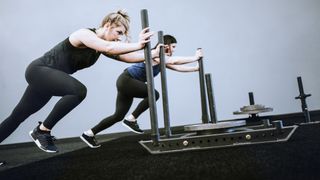
Shifting a prowler sled is a tough but low-impact move, which makes it a fine option for runners who go to the gym to cross-train. Grasp the handles of the sled as low down as possible – if you hold on too high you may apply force downwards rather than forwards – with either bent or straight arms. Then push off the balls of your feet to drive the sled forwards. Getting going is the hardest part; it gets somewhat easier after that. If you’re looking to develop power, choose a light weight and move fast, aiming for four one-minute rounds. For strength, load up the sled and do sets of short distances, resting after each effort.
Box jump
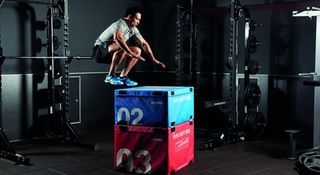
While some leg exercises increase your strength, this plyometric exercise will improve your power and can be a real pulse-raiser too. Find your gym’s plyo box – pick a height that you’re sure you can land comfortably on – and stand facing it square on. Looking at the box, pick a spot that you want to land on, squat down to half depth to help generate power then explode up, swinging your arms forwards as you do to ensure that your jump takes you onto the box. Land softly, bending your knees to absorb the shock, then stand. For your knees’ sake, step down from the box rather than jumping.
TRX Bulgarian split squat
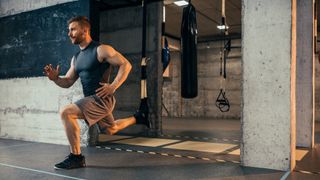
“This move both challenges single-leg stability and hits the posterior chain really hard,” says Page. “The position should resemble a lunge and targets similar muscle groups – the difference is that it recruits more muscle fibres.
“Face away from the rig with one of your feet in the handle of a TRX (or any suspension trainer), keeping your head up. Squat down on your standing leg. Ensure you are pushing back with the suspended leg and keeping your torso upright during the movement to minimise strain on the knee and maximise glute activation.
“At first, no weight will be needed and only light weights should be added as you progress.”
Hang clean
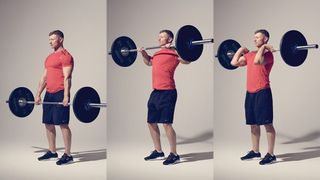
“The slower of the two Olympic lifts, the clean is a fantastic way to build power and explosiveness,” says Page, ”and the hang clean is a great version of the move to start with because it doesn’t require substantial mobility to perfect.
“Starting with the bar held at mid-thigh height, lower yourself into a powerful jumping position. Then forcibly extend your ankles, knees and hips to drive the bar up towards your shoulders. Drop under the bar, pivoting your arms around to catch it across the front of your shoulders. You should definitely ask one of the trainers in the gym for some tips before attempting this for the first time.”
Overhead squat
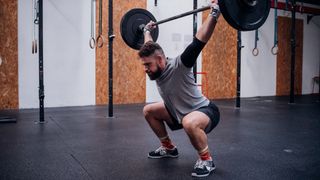
“If you can master the king of lower-body exercises, you’ll see the effect on your lower-body and core strength, shoulder stability, and mobility from your shoulders to your ankles,” says Page. “Holding a bar over the crown of your head, with your hands wider than shoulder-width apart, squat down as low as possible and use your glutes to drive back up to the starting position. Start with light loads until you master the technique – and prepare for a challenge!”

Nick Harris-Fry is a journalist who has been covering health and fitness since 2015. Nick is an avid runner, covering 70-110km a week, which gives him ample opportunity to test a wide range of running shoes and running gear. He is also the chief tester for fitness trackers and running watches, treadmills and exercise bikes, and workout headphones.

Nick Harris-Fry is a journalist who has been covering health and fitness since 2015. Nick is an avid runner, covering 70-110km a week, which gives him ample opportunity to test a wide range of running shoes and running gear. He is also the chief tester for fitness trackers and running watches, treadmills and exercise bikes, and workout headphones.
- Jake StonesContributor
